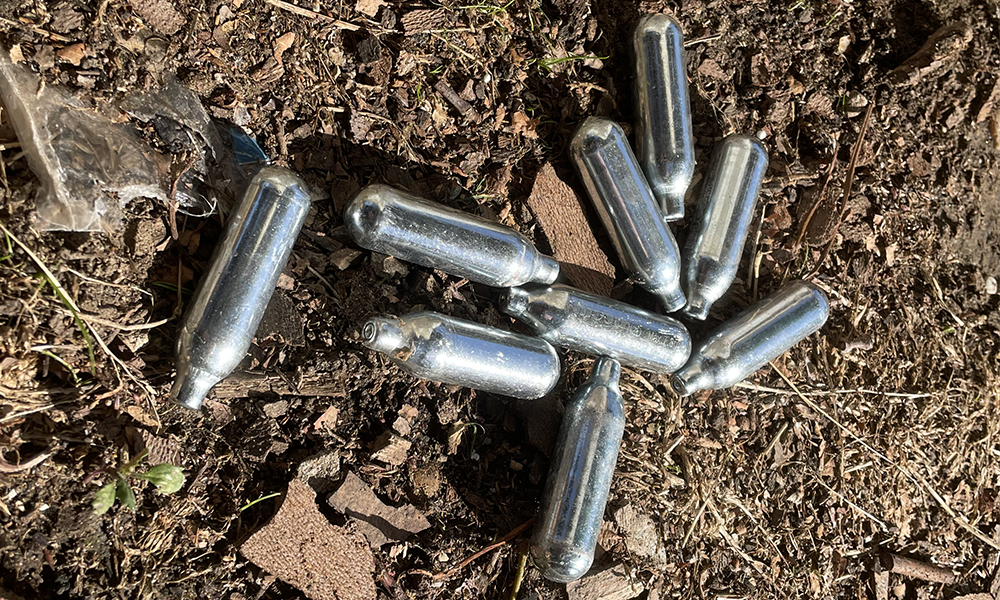Queen Mary University Of London professor and students launch awareness campaign about risks

Subscribe to Wharf Life’s weekly newsletter here
How do you feel about your nervous system?
How do you feel without your nervous system?
Jokes might seem appropriate here – after all, this article is about laughing gas.
Nitrous oxide, which comes in canisters of various sizes, is sold ostensibly for use in the baking industry as a means of creating robust whipped cream.
You have to be over 18 to buy it, but there are few practical obstacles to obtaining large quantities.
That’s perhaps why the gas is now also the most popular recreational drug for those aged 16-24. The effect of inhaling it – typically from a balloon – is described as a rapid rush of euphoria and a feeling of floating or excitement for a brief period.
Fits of giggles and laughter can also occur, hence the nickname.
Anyone walking around the Isle Of Dogs or east London will have seen multiple discarded canisters. It took me five minutes to find some to photograph for this piece.
A quick search on Google reveals a number of “baking websites” that subtly embrace a new found source of revenue, offering text alerts for discounts on cream chargers and next-day delivery for those who need their ingredients quickly.
Users have little trouble getting their hands on the canisters locally and antisocial behaviour associated with its use led to Tower Hamlets Council bringing in a Public Space Protection Order (PSPO) covering the whole borough last year.
This allows officers to issue fixed penalty notices of up to £100 or launch prosecutions with fines of up to £1,000 for using the drug and engaging in behaviour such as littering, noise nuisance and vandalism.
Since the PSPO came into force in April 2021, there have been 125 enforcement actions taken by officers, including a man who was fined £400 in court after failing to pay a fixed penalty notice.
The council says tackling use of the gas is a priority and that its enforcement officers regularly patrol the borough and take action against those using it.
It is also looking into boosting awareness around the dangers of inhaling the gas and the antisocial behaviour it can lead to.
Nevertheless, widespread nitrous oxide use continues locally. That may partly be because there’s a perception the gas is safe for recreational use.
This ignores the very real danger of inhaling the stuff directly from a canister, which can lead to a spasm in the throat that stops the user breathing.
More worryingly, there’s emerging evidence that use of nitrous oxide is leading to spinal injuries.
A steep rise in cases observed by Alastair Noyce, professor in neurology and neuroepidemiology at Queen Mary University’s Wolfson Institute Of Population Health, led him to launch a campaign this year to educate teenagers on the neurological risks of using the gas.
N20: Know The Risks is being led by students in the university’s Public Health And Preventative Medicine Society – supported by Professor Noyce – and has started to deliver sessions in Tower Hamlets through youth groups and housing associations.

Fourth year medical student Devan Mair, who is leading the campaign, said: “Our campaign focuses on the neurological dangers of taking nitrous oxide because they’re not very well known.
“This substance is a colourless gas which people inhale into their lungs.
The way it creates a high is to deprive a user’s brain of oxygen for a few seconds – it’s a very short high.
That in itself can create a risk, because people who do it a lot have been known to pass out and faint.
“The neurological risk is to do with the gas’ effect on the spinal cord – the clump of nerves running down the centre of the back that is connected to branches all the way around the rest of the body.
“Users of nitrous oxide risk damaging the myelin sheath – an insulating layer that forms around nerves made up of protein and fatty substances that allows electrical impulses to transmit quickly and efficiently along the nerve cells.
“Symptoms can include feelings of weakness, problems with balance, difficulty in walking or an inability to walk at all, constipation, urinary incontinence, pins and needles and in some cases a feeling like an electric shock going up the back.”
These problems stem from nitrous oxide’s ability to interfere with the body’s absorption of Vitamin B12 – a nutrient essential to a healthy myelin sheath.
The rise in cases has become so severe that Professor Noyce and local colleagues in east London are now working with neurologists around the country to establish the first national guidelines on treating nerve damage linked to laughing gas.
He said: “We are seeing more patients than even a year or so ago, and often the cases are more severe.
“We used to see people with tingling and numbness in their legs or difficulty walking, but this year we’ve had several people who literally can’t walk at all when they come to hospital.”
It’s cases such as those that have galvanised Devan and his fellow students into action.
“My motivation in getting involved is that I wasn’t aware of the risk until I was told about it – it’s something people simply don’t know,” he said.
“After school I did a gap year, working in special educational needs, so I got a taste for working with young people.
“We’re not here to lecture or scare anyone – we want to empower people with knowledge of the risks of nitrous oxide, to inform them if faced with the decision to take balloons, so they can make educated choices.
“If they’re presented with the evidence, they can make decisions for themselves.
“Our campaign has two main ways of raising awareness.
“Firstly, there’s social media – we have accounts on Instagram and Twitter where we provide infographics aimed at young people to explain what’s happening and how to get help.
“We also run interactive sessions where we deliver activities in a fun and engaging way – we don’t do too much talking but get people involved to help them understand what could happen in their bodies and why the damage is taking place.
“We also give people cards with the acronym NERV on – ‘N’ for notice the symptoms, ‘E’ for emergency help, ‘R’ for replacement of vitamin B12 and ‘V’ for value your health.
“We need this campaign to constantly be there because the problem isn’t going away. We’d definitely like to roll it out over a wider area – it’s just students here at the moment, so it’s quite small – we would like to make it bigger.
“It’s definitely something that’s relevant. In June we had two days at an event in Tower Hamlets where we collected data from 246 people – 97% said it was the first time they’d heard about nitrous oxide causing spinal damage and 86% felt confident after our session that they could tell their friends about the risks.
“We feel what we do works, now we want to grow it to reach more people.”
Read more: Quiet Rebels invade the stage at The Albany
Read Wharf Life’s e-edition here
Subscribe to Wharf Life’s weekly newsletter here
- Jon Massey is co-founder and editorial director of Wharf Life and writes about a wide range of subjects in Canary Wharf, Docklands and east London - contact via jon.massey@wharf-life.com




One Reply to “Isle Of Dogs: Why nitrous oxide use can lead to damage to nerves in the spinal cord”
Comments are closed.